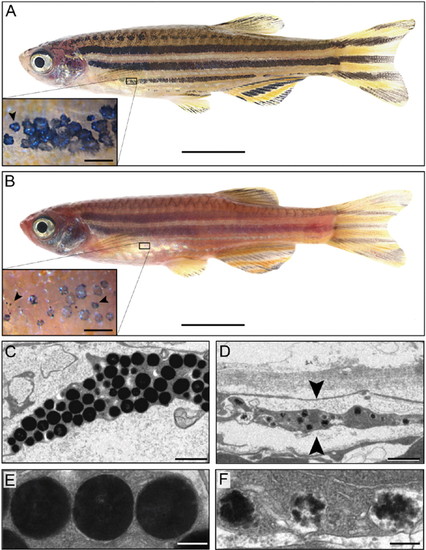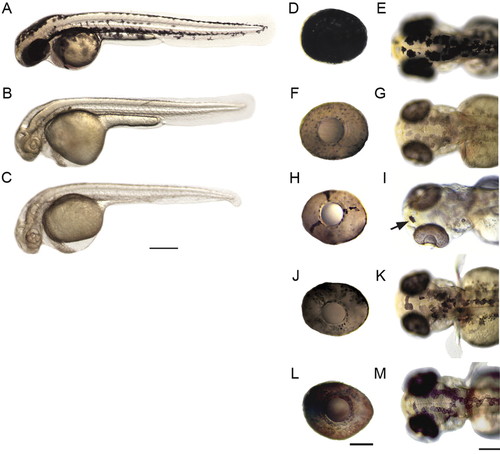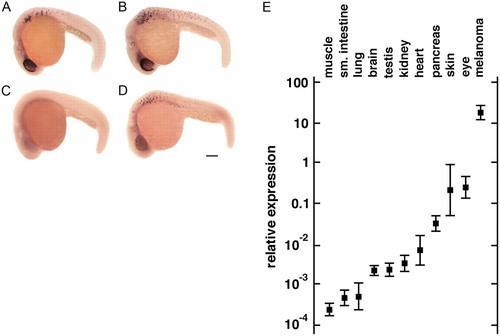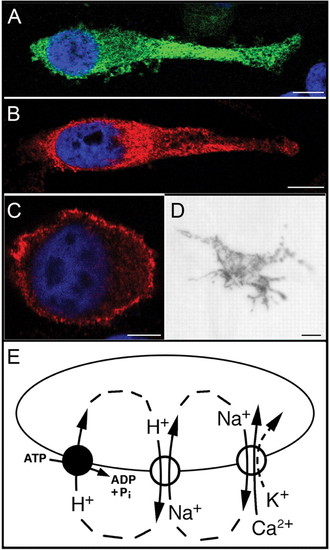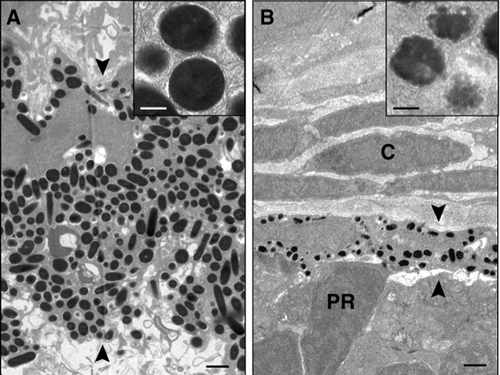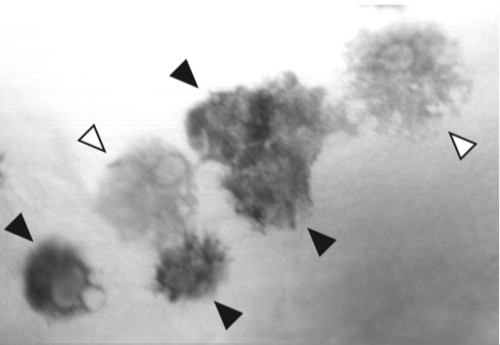- Title
-
SLC24A5, a putative cation exchanger, affects pigmentation in zebrafish and humans
- Authors
- Lamason, R.L., Mohideen, M.A., Mest, J.R., Wong, A.C., Norton, H.L., Aros, M.C., Jurynec, M.J., Mao, X., Humphreville, V.R., Humbert, J.E., Sinha, S., Moore, J.L., Jagadeeswaran, P., Zhao, W., Ning, G., Makalowska, I., McKeigue, P.M., O'donnell, D., Kittles, R., Parra, E.J., Mangini, N.J., Grunwald, D.J., Shriver, M.D., Canfield, V.A., and Cheng, K.C.
- Source
- Full text @ Science
|
Phenotype of golden zebrafish. Lateral views of adult wild-type (A) and golden (B) zebrafish. Insets show melanophores (arrowheads). Scale bars, 5 mm (inset, 0.5 mm). golb1 mutants have melanophores that are, on average, smaller, more pale, and transparent. Transmission electron micrographs of skin melanophore from 55-hpf wild-type (C and E) and golb1 (D and F) larvae. golb1 skin melanophores (arrowheads show edges) are thinner and contain fewer melanosomes than do those of wild type. Melanosomes of golb1 larvae are fewer in number, smaller, less-pigmented, and irregular compared with wild type. Scale bars in (C) and (D), 1000 nm; in (E) and (F), 200 nm. |
|
Rescue and morpholino knockdown establish slc24a5 as the golden gene. Lateral views of 48-hpf (A) wild-type and (B) golb1 zebrafish larvae. (C) 48-hpf wild-type larva injected with morpholino targeted to the translational start site of slc24a5 phenocopies the golb1 mutation. Lateral view of eye (D) and dorsal view of head (E) of 72-hpf wild-type embryos. (F and G) golb1 pigmentation pattern at 72 hpf, showing lightly pigmented cells. (H and I) 72 hpf golb1 larva injected with PAC215f11 show mosaic rescue; arrow identifies a heavily pigmented melanophore. (J and K) 72-hpf golb1 larva injected with full-length zebrafish slc24a5 RNA. (L and M) 72-hpf golb1 larvae injected with full-length human European (Thr111) SLC24A5 RNA. Rescue with the ancestral human allele (Ala111) is shown in fig. S4. Rescue in RNA-injected embryos is more apparent in melanophores (K) and (M) than in RPE. Scale bars in [(A) to (C)], 300 Ám; in (D), (F), (H), (J), and (L), 100 Ám; in (E), (G), (I), (K), and (M), 200 Ám. |
|
Expression of slc24a5 in zebrafish embryos and adult mouse tissues. The expression of slc24a5 (A) and dct (B) in melanophores and RPE of a 24-hpf wild-type zebrafish larva show similar patterns. (C) golb1 larvae lack detectable slc24a5 expression. (D) dct expression in 24-hpf golb1 larva is similar to that in wild type. Scale bar, 200 Ám. (E) Quantitative RT-PCR analysis of Slc24a5 expression in mouse tissues and B16 melanoma. Expression was normalized using the ratio between Slc24a5 and the control transcript, RNA polymerase II (Polr2e). EXPRESSION / LABELING:
|
|
Subcellular localization of slc24a5. Human MNT1 cells transfected with (A) GFP-tagged zebrafish slc24a5 (green) and (B) HA-tagged slc24a5 (red) clearly show intracellular expression. (C) HA-tagged D3 dopamine receptor localizes to the plasma membrane in MNT1 cells (red). 4′,6′-diamidino-2-phenylindole (DAPI) counterstain was used to visualize nuclei (blue). Scale bars in (A) and (B), 10 Ám; in (C), 5 Ám. (D) Rescue of dark pigmentation in a melanophore of a golden embryo by HA-tagged slc24a5. These dark cells appear in golden embryos injected with the HA-tagged construct, but not in mock-injected embryos. Scale bar, 10 Ám. (E) Model for calcium accumulation in melanosomes. Protons are actively transported into the melanosome by the V-ATPase (left). The proton electrochemical potential gradient drives sodium uptake via the sodium (Na+)/proton (H+) exchanger (center). Sodium efflux is coupled to calcium uptake by the slc24a5 polypeptide (right). If potassium (dashed arrow) is cotransported with calcium, it must either accumulate within the melanosome or exit by means of additional transporters (not depicted). Pi, inorganic phosphate; ADP, adenosine diphosphate. |
|
The golden phenotype in retinal pigment epithelium. (A) Wild-type RPE cells (72 hpf) are large and contain numerous large, round melanosomes. (B) The RPE cells of golb1 are much smaller and contain fewer melanosomes. These melanosomes are smaller and less densely pigmented. Arrowheads indicate boundaries of the RPE. PR, photoreceptor cell; C, choroid. Scale bars: 1000nm (150nm inset). |
|
Rescue of the zebrafish golden phenotype by human SLC24A5(Ala111). Neighboring darkly pigmented (SLC24A5+, filled arrowheads) and lightly pigmented golden (gol) cells (open arrowheads) in 60 hpf golden embryos following injection of golden zygotes with a DNA expression plasmid containing human SLC24A5(Ala111). |

